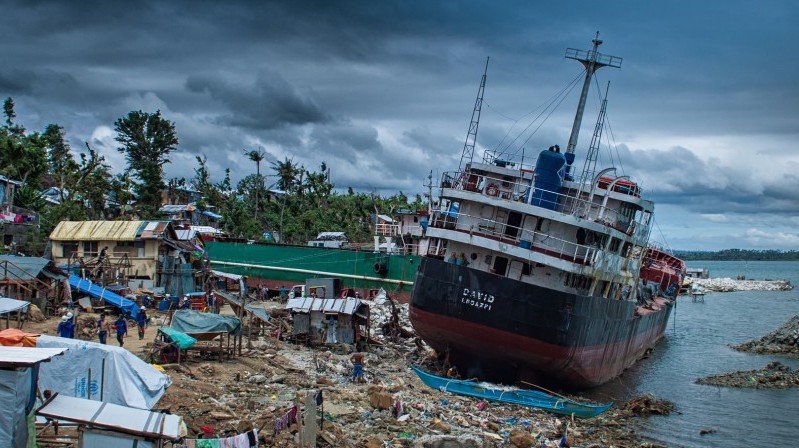Powerful tropical storms − known variously as cyclones, typhoons and hurricanes − bring death and destruction to huge swathes of the Earth’s surface. And new research suggests that they are likely to become even stronger.
Storms such as the super-typhoon Nepartak that scoured Taiwan earlier this month with winds of 150 miles per hour and then flooded parts of China, are expected to grow even fiercer as the planet warms. That trend is not clear yet, but scientists in the US say it soon will be.
Ironically, one of the main reasons why these storms will gain in power is the effort in many countries to reduce air pollution. Damaging as it is in stunting and shortening lives, the one arguable benefit of filthy air is its ability to dampen the effects of greenhouse gases (GHGs) on cyclones and their like.
Over the last century, tiny airborne particles called aerosols, which cool the climate by absorbing and reflecting sunlight, have largely cancelled out the effects of GHG emissions on tropical storm intensity, according to a new scientific review paper published in Science journal.
Weekly briefing: Sign up for your essential climate politics update
Many aerosols are emitted by the burning of fossil fuels and wood, and cause lung damage, also adding to acid rain and smog. Industry, transport and power plants in more and more countries have introduced filters and scrubbers to reduce their impact, and atmospheric levels of aerosols from human causes have begun to decline. But GHG concentrations continue to rise.
The authors of the Science journal report provide new calculations on the cancelling effects of aerosols and GHGs on tropical cyclones.
“The fact that global warming’s fingerprints don’t yet jump out at us when we look at hurricanes isn’t surprising – it’s what current science tells us we should expect,” says lead author Adam Sobel, professor of Earth and environmental sciences at Columbia University’s Lamont-Doherty Earth Observatory and School of Engineering.
“The same science tells us that those fingerprints will show up eventually in more ultra-powerful storms.”
They examined a wide range of published analyses of tropical cyclone data and computer modelling, looking specifically at potential intensity, which predicts the maximum intensity the storms could reach in a given environment.
Their new calculations of the cancelling effect follow a 2015 study on hurricanes, led by Lamont’s Mingfang Ting, with fellow research professor Suzana Camargo, also a co-author of the new paper. It showed similar effects over the North Atlantic, where hurricanes that make landfall in the US form.
“The science tells us that [global warming’s] fingerprints will show up eventually in more ultra-powerful storms”
Many factors determine the intensity of a tropical storm such as the notorious Hurricane Katrina in 2005 and Superstorm Sandy in 2012.
Its convective strength – the boiling motion of air rising from the ocean surface to the atmosphere – depends on the temperature difference between the surface ocean and the upper atmosphere.
Computer models that simulate the physics of tropical cyclones suggest that this difference should increase as the climate and sea surface temperatures warm, and that storm strength should increase with it.
But something that is less well understood is how climate change should influence the number of cyclones that form each year. Computer models show that, while the total number should decline in a warming climate, more intense, highly destructive storms such as Nepartak are likely to become more common.
The scientists say the largest increases in tropical cyclone potential intensity are expected to be at the margins of the tropics, particularly in the Atlantic and Pacific.
The amount of rain that tropical storms bring is also expected to increase as the planet warms, because of increasing water vapour. And coastal flooding from storm surges that accompany tropical storms is expected to become more of a problem as sea levels rise.
Response to warming
The scientists also describe a shift in tropical cyclone tracks towards the tropics’ outer edges, although it is unclear whether the shift is a response to warming. Simulations for the western North Pacific suggest that it is, at least in part.
Two factors make it hard to detect GHG-related trends in tropical cyclone intensity, the authors say. One is the influence of aerosols, which models show have about twice the effect of GHGs on a tropical cyclone’s potential intensity.
So while GHG levels have been greater than aerosol levels for many decades in terms of absolute magnitude, they have only recently overtaken the cooling effect of aerosols in terms of their influence on storm intensity.
The other challenge is natural variability. Tropical cyclones are relatively rare, averaging around 90 a year, and that number fluctuates annually and from decade to decade − largely because of natural causes. It is statistically difficult to detect long-term trends within that large natural variability.
Scientists at Lamont are developing a tropical cyclone risk model that can be used in urban planning, which incorporates climate factors in determining the probability of a tropical cyclone making landfall at a given location.
This article was produced by Climate News Network
